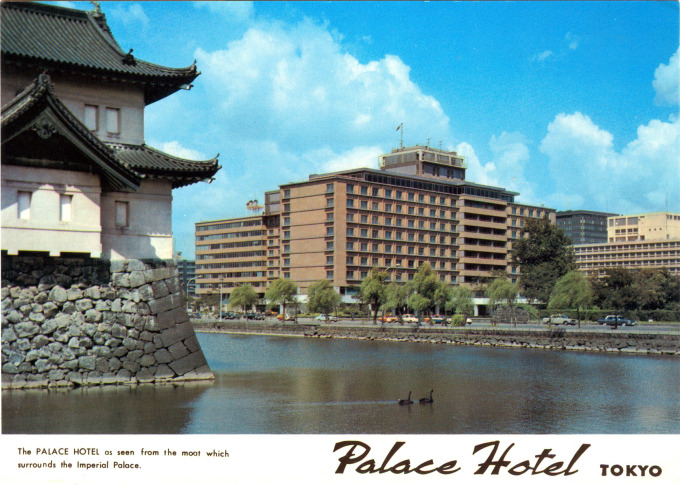See also:
Hotel Teito, Tokyo

Aerial view of Yurakucho and Marunouchi, c. 1970. The Palace Hotel can seen in the upper-left among the cluster of palace moats near the Otemachi gate.
“Our first impressions of Japan were positive as the customs official at the airport ushered us through with a smile. Marian, our travel agent, had booked our hotel for us. It was the Palace Hotel. When we inquired how to get there we were referred to the hotel bus service which would take us and others to our city hotels.
“Soon our small bus was racing through the neon-lit highways of Tokyo. At this time Tokyo had the reputation for being the city with the world’s worst traffic jams. It did not surprise me considering the quantity of traffic I saw on the road even though it was very late at night. Fortunately we did not experience any delays and soon our bus stopped outside the 5-star Palace Hotel.
“Marian had really done us proud because the Palace looked luxurious and the reason for its name was soon obvious – it was opposite the home of the Emperor of Japan! Since the 1960s Tokyo has gained a further reputation, for having the most expensive hotels in the world. What a short stay at Palace costs now, I hesitate to think, but at least when we stopped there [in 1969] our room cost ¥660 per day and our Australian dollars went a long way.”
– Cast Into the Unknown, by Mike W. Harry, 2008

Aerial view of the Palace Hotel, c. 1970, relative to the Imperial Palace’s Otemachi Gate and palace moats, showing the hotel’s rooftop terrace (right) and greenhouse adjoining the spacious Crown Restaurant.
The Palace Hotel was the replacement to the Hotel Teito (1937-1960) on the same site. Officially opened on 1 October 1961 and celebrated with a gala reception attended by prominent figures from throughout Japan and overseas, the privately owned and managed hotel was the first hotel in Tokyo to be multi-purposed – sharing premises with an office building.
It was the most contemporary hotel of its time. The 450-room Palace Hotel featured extensive facilities, the latest in modern travel comforts, and very distinctive architecture. Its outer walls were clad with approximately 1.6 million shigaraki * tiles, an unprecedented use of a traditional material that earned the hotel an Architectural Industry Association Prize in 1963.
In 2009, after having serviced travelers for nearly half a century, the Palace Hotel closed its doors and was razed in preparation for its new incarnation as a 23-story luxury caravansary. This new Palace Hotel opened its doors in 2013 retaining, in recognition of past good fortunes, the shigaraki tiles that had lined the original hotel.
- Aerial view of the Palace Hotel, Tokyo, c. 1965.
- Palace Hotel, c. 1965.
- View from the Swan Dining Room. Palace Hotel, Tokyo, c. 1965.
- Swan Dining Room, Palace Hotel, c. 1965.
- Crown Restaurant, Palace Hotel, c. 1965.
- View from the Palace Hotel, Tokyo, c. 1965. Tokyo Tower is in the distance.
Personal note: After our family move to Tokyo in the summer of 1970, the Palace Hotel was our “home” for six weeks. The hotel was within walking distance to Tokyo Central Station and the Marunouchi business district (where my father worked), and close, too, to Hibiya Park, Nihonbashi, Ginza and Shimbashi. Those neighborhoods were my first introductions to Tokyo and Japan.









Pingback: Hotel Teito | Old Tokyo
Pingback: Hotel Teito, Tokyo. | Old TokyoOld Tokyo